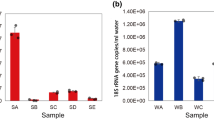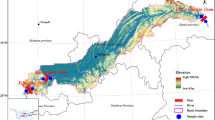Abstract
Eukaryotes are critical regulators of ecosystem functions in river systems. However, little is known about vertical micro-eukaryotic composition, diversity, and assembly patterns in urban aquaculture systems under vertical geochemical gradients. Molecular analysis based on 18S rRNA gene sequencing was performed to investigate the spatial variation in the eukaryotic community in six layers of different depths in water and sediments in the Jinchuan River of Nanjing, China. SAR and Opisthokonta were the most abundant groups, comprising 75.19% and 10.54% of the total sequences in water and 32.43% and 44.10% of the total sequences in sediment, respectively. The composition, diversity, and assembly patterns of eukaryotic microbes varied regionally and spatially in different layers. The abundance of Paramecium increased, and that of Ploimida decreased as the level of water pollution increased in water layers. In sediment layers, Cyclotella, Ochromonas, and Stentor were more abundant in less-polluted sites. In addition, depth-related differences could also be observed among eukaryotes in different layers. Paramecium was most common across all water layers with an average relative abundance of 19.64%, while LKM11 dominated the community in sediment (18.79%). Statistics of the beta-diversity patterns suggested that a higher level of river pollution probably leads to greater heterogeneity in eukaryotic community composition (BSOR-C > BSOR-A > BSOR-D > BSOR-B). Vertical beta-diversity patterns in the eukaryotic community primarily resulted from species replacement, which was mainly driven by spatial turnover (βSIM = 0.4471 in water and 0.6662 in sediment) rather than nestedness (βNES = 0.0292 in water and 0.0188 in sediment).





Similar content being viewed by others
Data Availability
Not applicable.
References
Baselga, A. (2010). Partitioning the turnover and nestedness components of beta diversity. Global Ecology and Biogeography, 19(1), 134–143.
Burakov, A. E., Galunin, E. V., Burakova, I. V., Kucherova, A. E., Agarwal, S., Tkachev, A. G., & Gupta, V. K. (2018). Adsorption of heavy metals on conventional and nanostructured materials for wastewater treatment purposes: a review. Ecotoxicology and Environmental Safety, 148, 702–712.
Cai, W., Li, Y., Shen, Y., Wang, C., Wang, P., Wang, L., et al. (2019). Vertical distribution and assemblages of microbial communities and their potential effects on sulfur metabolism in a black-odor urban river. Journal of Environmental Management, 235, 368–376.
Castillejo, P., Chamorro, S., Paz, L., Heinrich, C., Carrillo, I., Salazar, J. G., et al. (2018). Response of epilithic diatom communities to environmental gradients along an Ecuadorian Andean river. Comptes Rendus Biologies, 341(4).
Chen, M., Chen, F., Zhao, B., Wu, Q. L., & Kong, F. (2010). Seasonal variation of microbial eukaryotic community composition in the large, shallow, subtropical Taihu Lake, China. Aquatic Ecology, 44(1), 1–12.
Dorigo, U., Bérard, A., & Humbert, J. F. (2002). Comparison of eukaryotic phytobenthic community composition in a polluted river by partial 18s rRNA gene cloning and sequencing. Microbial Ecology, 44(4), 372–380.
Freytet, P., & †, E.P.V. (2010). Freshwater organisms that build stromatolites: a synopsis of biocrystallization by prokaryotic and eukaryotic algae. Sedimentology, 45(3), 535–563.
Gupta, V. K., Ali, I., Saleh, T. A., Siddiqui, M. N., & Agarwal, S. (2013). Chromium removal from water by activated carbon developed from waste rubber tires. Environmental Science and Pollution Research, 20(3), 1261–1268.
Huang, Y. L., & Huang, J. L. (2019). Coupled effects of land use pattern and hydrological regime on composition and diversity of riverine eukaryotic community in a coastal watershed of Southeast China. Science of the Total Environment, 660, 787–798.
Isabwe, A., Yang, J. R., Wang, Y., Liu, L., Chen, H., & Yang, J. (2018). Community assembly processes underlying phytoplankton and bacterioplankton across a hydrologic change in a human-impacted river. Science of the Total Environment, 630, 658–667.
Jiang, Y. J., He, W., Liu, W. X., Qin, N., Ouyang, H. L., Wang, Q. M., et al. (2014). The seasonal and spatial variations of phytoplankton community and their correlation with environmental factors in a large eutrophic Chinese lake (Lake Chaohu). Ecological Indicators, 40(5), 58–67.
Jost, L. (2007). Partitioning diversity into independent alpha and beta components. Ecology, 88, 2427–2439.
Korajkic, A., Parfrey, L. W., Mcminn, B. R., Baeza, Y. V., Vanteuren, W., Knight, R., et al. (2015). Changes in bacterial and eukaryotic communities during sewage decomposition in Mississippi river water. Water Research, 69, 30–39.
Lara, E., Moreira, D., & López-García, P. (2010). The environmental clade LKM11 and Rozella form the deepest branching clade of fungi. Protist, 161(1), 116–121.
Lefranc, M., The’not, A., & Lepe’re, C. (2005). Genetic diversity of small eukaryotes in lakes differing by their trophic status. Applied and Environmental Microbiology, 71(10), 5935–5942.
Lepe’re, C., Boucher, D., Jardillier, L., Domaizon, I., & Debroas, D. (2006). Succession and regulation factors of small eukaryote community composition in a lacustrine ecosystem (Lake Pavin). Applied and Environmental Microbiology, 72(4), 2971–2981.
Lepère, C., Masquelier, S., Mangot, J. F., Debroas, D., & Domaizon, I. (2010). Vertical structure of small eukaryotes in three lakes that differ by their trophic status: a quantitative approach. ISME Journal, 4(12), 1509–1519.
Mikawa, M., Sugimoto, K., Amano, Y., Machida, M., & Imazeki, F. (2016). Competitive growth characteristics between Microcystis aeruginosa and Cyclotella sp. accompanying changes in river water inflow and their simulation model. Phycological Research, 64(3), 123–132.
Moisan, J. R., Moisan, T. A., & Abbot, M. R. (2002). Modelling the effect of temperature on the maximum growth rates of phytoplankton populations. Ecological Modelling, 153(3), 197–215.
Nekouei, F., Nekouei, S., Tyagi, I., & Gupta, V. K. (2015). Kinetic, thermodynamic and isotherm studies for acid blue 129 removal from liquids using copper oxide nanoparticle-modified activated carbon as a novel adsorbent. Journal of Molecular Liquids, 201, 124–133.
Pernthaler, J. (2005). Predation on prokaryotes in the water column and its ecological implications. Nature Reviews Microbiology, 3(7), 537–546.
Proia, L., Anzil, A., Subirats, J., Borrego, C., Farrè, M., Llorca, M., et al. (2018). Antibiotic resistance along an urban river impacted by treated wastewaters. Science of the Total Environment, 628-629, 453–466.
Qian, H., Ricklefs, R. E., & White, P. S. (2005). Beta diversity of angiosperms in temperate floras of eastern Asia and eastern North America. Ecology Letters, 8, 15–22.
Stewart, P. M., Smith, E. P., Pratt, J. R., Mccormick, P. V., & Cairns, J. (1986). Multivariate analysis of protist communities in lentic systems. Journal of Eukaryotic Microbiology, 33(2), 152–156.
Takishita, K., Yubuki, N., Kakizoe, N., Inagaki, Y., & Maruyama, T. (2007). Diversity of microbial eukaryotes in sediment at a deep-sea methane cold seep: surveys of ribosomal DNA libraries from raw sediment samples and two enrichment cultures. Extremophiles, 11(4), 563–576.
Ulrich, W., & Gotelli, N. J. (2007). Null model analysis of species nestedness patterns. Ecology, 88, 1824–1831.
Van Hannen, E. J., Zwart, G., van Agterveld, M. P., Gons, H. J., Ebert, J., & Laanbroek, H. J. (1999). Changes in bacterial and eukaryotic community structure after mass lysis of filamentous cyanobacteria associated with viruses. Applied and Environmental Microbiology, 65(2), 795–801.
Walters, E., Graml, M., Behle, C., Müller, E., Horn, H. (2014). Influence of particle association and suspended solids on UV inactivation of fecal indicator bacteria in an urban river. Water, Air, and Soil Pollution, 225(1), 1822.
Wurzbacher, C., Fuchs, A., Attermeyer, K., Frindte, K., Grossart, H. P., Hupfer, M., et al. (2017). Shifts among eukaryota, bacteria, and archaea define the vertical organization of a lake sediment. Microbiome, 5(1), 41.
Xue, Y. Y., Chen, H. H., Yang, J. R., Liu, M., Huang, B. Q., & Yang, J. (2018). Distinct patterns and processes of abundant and rare eukaryotic plankton communities following a reservoir cyanobacterial bloom. The ISME Journal, 12, 2263–2277.
Zancarini, A., Echeniquesubiabre, I., Debroas, D., Taïb, N., Quiblier, C., & Humbert, J. F. (2017). Deciphering biodiversity and interactions between bacteria and microeukaryotes within epilithic biofilms from the Loue River, France. Scientific Reports, 7(1), 4344.
Zhang, N., Xiao, X., Pei, M., Liu, X., & Liang, Y. (2016). Discordant temporal turnovers of sediment bacterial and eukaryotic communities in response to dredging: non-resilience and functional changes. Applied and Environmental Microbiology, 83(1), 02526–02516.
Funding
This work was supported by the National Natural Science Foundation of China (no. 51779076, no. 51909229, no. 51809226), the Foundation for Innovative Research Groups of the National Natural Science Foundation of China (no. 51421006), the Social Development Projects of Science and Technology Office of Jiangsu Province (no. BE2018738), the Priority Academic Program Development of Jiangsu Higher Education Institutions (PAPD), the Six Talent Peaks Project in Jiangsu Province (no. 2016-JNHB-007), the 333 High Level Talents training Project of Jiangsu Province, and the Fundamental Research Funds for the Central Universities (no. 2018B47814).
Author information
Authors and Affiliations
Corresponding author
Ethics declarations
Conflict of Interest
The authors declare that they have no conflict of interest.
Ethics Approval
Not applicable.
Consent to Participate
Written informed consent for participation was obtained from all participants.
Consent for Publication
Written informed consent for publication was obtained from all participants.
Code Availability
Not applicable.
Additional information
Publisher’s Note
Springer Nature remains neutral with regard to jurisdictional claims in published maps and institutional affiliations.
Electronic Supplementary Material
ESM 1
(DOCX 50 kb)
Rights and permissions
About this article
Cite this article
Cai, W., Li, Y., Zhang, W. et al. Composition, Distribution, and Assembly Patterns of Eukaryotic Communities Under Vertical Geochemical Gradients in a Polluted Urban River. Water Air Soil Pollut 231, 335 (2020). https://doi.org/10.1007/s11270-020-04700-0
Received:
Accepted:
Published:
DOI: https://doi.org/10.1007/s11270-020-04700-0




